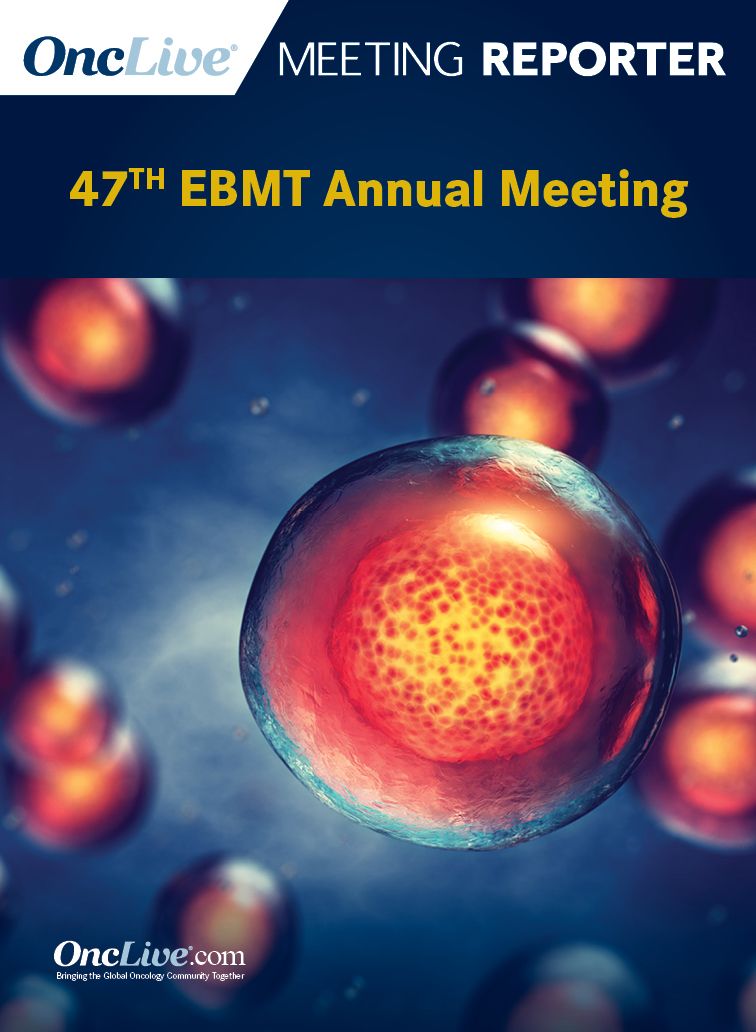Publication
Article
AB-205 Shows Tolerability, Robust Effects in Patients With Lymphoma Undergoing HDT-ASCT
Author(s):
The engineered cord endothelial cell product AB-205 showed an encouraging safety profile along with robust effects in eliminating oral/gastrointestinal severe regimen-related toxicities in patients with systemic lymphoma undergoing high-dose therapy and autologous hematopoietic stem cell transplantation.
Carolyn Mulroney, MD

The engineered cord endothelial cell (E-CEL) product AB-205 showed an encouraging safety profile along with robust effects in eliminating oral/gastrointestinal (GI) severe regimen-related toxicities (SRRT) in patients with systemic lymphoma undergoing high-dose therapy and autologous hematopoietic stem cell transplantation (HDT-AHCT), according to interim results of the phase 1b/2 AB-205-001 trial that were presented during the Virtual 47th Annual Meeting of the EBMT.
Overall, the agent was found to be well tolerated with no clinically significant infusion-related reactions. The adverse events (AEs) reported on study were consistent with that in an AHCT population, and the maximum-tolerated dose was not reached, explained lead study author Carolyn Mulroney, MD, in a presentation during the meeting.
“AB-205 has significant potential to address a serious unmet need in patients undergoing HDT-AHCT,” said Mulroney,a hematologist/medical oncologist, and associate professor of medicine at University of California San Diego Health. “This drug has been granted Orphan Drug Designation by the FDA. The highest dose of 20 x 106 E-CEL/kg demonstrated robust effect in eliminating oral/GI severe regimen-related toxicities.”
HDT-AHCT is potentially curative for patients who have high-risk, chemotherapy-sensitive lymphomas. Additionally, while HDT eradicates malignant cells, it also can cause severe injury to healthy tissues via vascular endothelial damage. Some of these are SRRT, which lead to high symptom burden and life-threatening organ toxicities. The risk of these SRRTs could make select patients ineligible for AHCT, especially in those who are older.
Moreover, while hematopoiesis is largely rescued by AHCT, there are no effective treatments that are able to repair endothelial damage, Mulroney explained.
AB-205 is an off-the-self E-CEL product comprised of allogeneic human E4*CD31*umbilical endothelial cells. These engineered cells can respond to cytokines produced by damaged cells and release angiocrine factors that act via juxtacrine and paracrine mechanisms and support microvasculature repair through interactions with intact endothelial cells.
Data from preclinical models demonstrated that AB-205 restores the natural healing process of the marrow, spleen, and GI tract, and that it also accelerates hematopoietic recovery and increases survival following LD50 irradiation.
In the phase I dose-escalation study (NCT03925935), investigators enrolled patients with non-Hodgkin lymphoma (NHL) and Hodgkin lymphoma undergoing their first hematopoietic stem cell transplant, and were eligible for HDT-AHCT; an ECOG performance status of 0 to 1 was required. Localized radiation and posttransplant maintenance were permitted.
Cohorts were enrolled sequentially following safety assessment of the previous cohort. Doses were as follows: 5 x 106 E-CEL/kg on day 0 (cohort 1), 10 x 106 E-CEL/kg on day 0 (cohort 2), 20 x 106 E-CEL/kg on day 0 (cohort 3), and 20 x 106 E-CEL/kg in a split dose of 50% on day 0 and the other remaining 50% on day 2 (cohort 4).
AB-205 was administered intravenously, and high-dose therapy regimens consisted of carmustine, etoposide, cytarabine, and melphalan (BEAM); bendamustine, etoposide, cytarabine, and melphalan (BeEAM); cyclophosphamide, carmustine, and etoposide (CBV); and thiotepa, busulfan, and cyclophosphamide (TBC).
Patients received standard of care prophylaxis and supportive care.
The primary end point was safety; secondary end points included severe and duration of grade 3 or higher oral/GI toxicities, and time to neutrophil and platelet engraftment. Exploratory outcome measures were progression-free survival (PFS), non-relapse mortality, overall survival (OS), and lymphoid recovery.
In order to establish a modern historical control concurrent with study enrollment, a chart review was concurrently conducted of 45 consecutive patients undergoing AHCT for systemic lymphoma. Patients received conditioning with HDT with BEAM, BeEAM, or CBV from 2019 to 2020.
Baseline characteristics were stratified between 2 dose ranges of AB-205 (<20 x 106 E-CEL/kg and 20 x 106 E-CEL/kg) and the chart review cohort. In total, the median age was 56.6 years, and 37.6% of patients were younger than 60 years. Sixty-two percent of patients were male, and 71% were diagnosed with NHL. The median number of prior therapies was 2; HDT regimens were BEAM (87.6%), BeEAM (9.3%), and CBV (3%). The median CD34+ count was 4.56 x 106/kg.
The median duration of follow-up was 8.1 months (range, 3.7-16.6) and no deaths occurred in the 29 patients. One patient, who was a 61-year-old male with stage IV diffuse large B-cell lymphoma and had a partial response to 2 lines of chemoradiation, relapsed at day +101.
No evidence suggested that AB-205 has a detrimental effect on either PFS or OS, Mulroney said.
Safety data were evaluable for 29 patients with systemic lymphomas. Patients experienced treatment-emergent AEs and serious AEs occurred in 31% of patients. Additionally, 1 dose-limiting toxicity, which was prolonged thrombocytopenia (>28 days) was observed during dose escalation at the 10 x 106 E-CEL/kg-dose. This was considered to be unrelated to study treatment.
In the <20 x 106 E-CEL/kg cohort (n = 11), AEs were hypokalemia, oral mucositis, supraventricular tachycardia, upper respiratory infection, and epistaxis (9% each; n = 1 each). In the 20 x 106 E-CEL/kg (n = 18), hypokalemia occurred in 11% of patients; angina pectoris, sepsis, enterocolitis infectious, depression, hyperkalemia, hypocalcemia, dehydration, hypertension occurred at 6% each (n = 1 each).
The clinically meaningful end point of oral/GI SRRT, which was defined as grade 3 or higher oral mucositis, nausea/vomiting, or diarrhea, was also evaluated. Low-rates of this SRRT were reported with the <20 x 106 E-CEL/kg dose (9%) and the 20 x 106 E-CEL/kg dose (0%) when compared with the control cohort (60%).
Oral/GI regimen-related toxicities, which were defined as all-grade events, were at lower rates with AB-205 at both the <20 x 106 E-CEL/kg and 20 x 106 E-CEL/kg doses in regard to oral mucositis (64% and 50%, respectively), nausea/vomiting (64% and 28%), diarrhea (82% and 50%). The control cohorts were 69%, 89%, and 82%, respectively.
Investigators also evaluated time to neutrophil and platelet engraftment. The median time to neutrophil engraftment was 10 days, the median time to platelet engraftment was 11 days, and the rate of platelet engraftment within 1 day of neutrophil engraftment was 69%. The median time to discharge from AHCT was 12 days.
In the chart review, the median neutrophil engraftment, platelet engraftment, and rate of platelet engraftment within 1 day of neutrophil engraftment was 12, 18, and 16%, respectively. The median time to charge from AHCT was 16 days.
Mulroney added that these data were the basis for the FDA’s Regenerative Medicine Advanced Therapy designation, and the findings were the subject of an end-of-phase 2 meeting with the regulatory agency.
A pivotal, double-blind, placebo-controlled, randomized study for potential registration with AB-205 is planned for US and EU sites.
Reference
Mulroney C, Scordo M, Abedi M, et al. Open label dose escalation trial of AB-205 (E-CEL® cells) in adults with systemic lymphoma undergoing high-dose therapy and autologous hematopoietic cell transplantation (HDT-AHCT). Presented at: 47th Annual Meeting of the EBMT; March 14-17, 2021; virtual.










